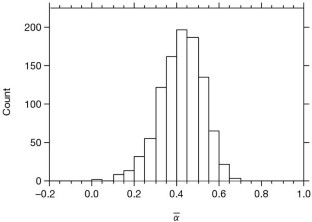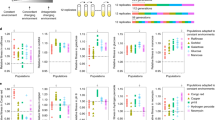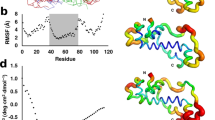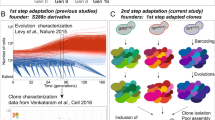Abstract
For over 30 years a central question in molecular evolution has been whether natural selection plays a substantial role in evolution at the DNA sequence level1,2. Evidence has accumulated over the last decade that adaptive evolution does occur at the protein level3,4, but it has remained unclear how prevalent adaptive evolution is. Here we present a simple method by which the number of adaptive substitutions can be estimated and apply it to data from Drosophila simulans and D. yakuba. We estimate that 45% of all amino-acid substitutions have been fixed by natural selection, and that on average one adaptive substitution occurs every 45 years in these species.
This is a preview of subscription content, access via your institution
Access options
Subscribe to this journal
Receive 51 print issues and online access
$199.00 per year
only $3.90 per issue
Buy this article
- Purchase on Springer Link
- Instant access to full article PDF
Prices may be subject to local taxes which are calculated during checkout

Similar content being viewed by others
References
Gillespie, J. H. The Causes of Molecular Evolution (Oxford Univ. Press, Oxford, 1991).
Kimura, M. The Neutral Theory of Molecular Evolution (Cambridge Univ. Press, Cambridge, 1983).
Kreitman, M. & Akashi, H. Molecular evidence for natural selection. Annu. Rev. Ecol. Syst. 26, 403–422 (1995).
Yang, Z. & Bielawski, J. P. Statistical methods for detecting molecular adaptation. Trends Ecol. Evol. 15, 496–503 (2000).
Charlesworth, B. The effect of background selection against deleterious mutations on weakly selected, linked variants. Genet. Res. 63, 213–227 (1994).
Fay, J., Wycoff, G. J. & Wu, C.-I. Positive and negative selection on the human genome. Genetics 158, 1227–1234 (2001).
McDonald, J. H. & Kreitman, M. Adaptive evolution at the Adh locus in Drosophila. Nature 351, 652–654 (1991).
Charlesworth, B., Morgan, M. T. & Charlesworth, D. The effect of deleterious mutations on neutral molecular variation. Genetics 134, 1289–1303 (1993).
Maynard Smith, J. & Haigh, J. The hitch-hiking effect of a favourable gene. Genet. Res. 23, 23–35 (1974).
Begun, D. J. & Aquadro, C. F. levels of naturally occuring DNA polymorphism correlate with recombination rates in D. melanogaster. Nature 356, 519–520 (1992).
Begun, D. The frequency distribution of nucleotide variation in Drosophila simulans. Mol. Biol. Evol. 18, 1343–1352 (2001).
Kliman, R. Recent selection on synonymous codon usage in Drosophila. J. Mol. Evol. 49, 343–351 (1999).
Adams, M. D. et al. The genome sequence of Drosophila melanogaster. Science 287, 2185–2195 (2000).
Powell, J. R. & DeSalle, R. Drosophila molecular phylogenies and their uses. Evol. Biol. 28, 87–138 (1995).
Haldane, J. B. S. The cost of natural selection. J. Genet. 55, 511–524 (1957).
Kimura, M. Evolutionary rate at the molecular level. Nature 217, 624–626 (1968).
Thompson, J. D., Higgins, D. G. & Gibson, T. J. ClustalW—improving the sensitivity of progressive multiple alignment through sequence weighting, position-specific gap penalties and weight matrix choice. Nucl. Acids Res. 22, 4673–4680 (1994).
Xia, X. Data Analysis in Molecular Biology and Evolution (Kluwer Academic, London, 2000).
Rozas, J. & Rozas, R. DnaSP version 3: an integrated program for molecular population genetics and molecular evolution analysis. Bioinformatics 15, 174–175 (1999).
Yang, Z. PAML: a program package for phylogenetic analysis by maximum likelihood. Comput. Appl. Biosci. 13, 555–556 (1997).
Acknowledgements
We thank B. Charlesworth, C.-I. Wu, S. Otto, M. Whitlock, T. Johnson, P. Awadalla, J. Gillespie, G. McVean and P. Keightley for helpful discussions, and E. Moriyama for help with data collection. N.G.C.S. was funded by the Biotechnology and Biological Sciences Research Council (BBSRC) and A.E.-W. is funded by the Royal Society and the BBSRC.
Author information
Authors and Affiliations
Corresponding author
Ethics declarations
Competing interests
The authors declare no competing financial interests.
Supplementary information
Rights and permissions
About this article
Cite this article
Smith, N., Eyre-Walker, A. Adaptive protein evolution in Drosophila. Nature 415, 1022–1024 (2002). https://doi.org/10.1038/4151022a
Received:
Accepted:
Issue Date:
DOI: https://doi.org/10.1038/4151022a
This article is cited by
-
Indel driven rapid evolution of core nuclear pore protein gene promoters
Scientific Reports (2023)
-
Copy number changes in co-expressed odorant receptor genes enable selection for sensory differences in drosophilid species
Nature Ecology & Evolution (2022)
-
An inferred fitness consequence map of the rice genome
Nature Plants (2020)
-
Variation of the adaptive substitution rate between species and within genomes
Evolutionary Ecology (2020)
-
Exploiting selection at linked sites to infer the rate and strength of adaptation
Nature Ecology & Evolution (2019)
Comments
By submitting a comment you agree to abide by our Terms and Community Guidelines. If you find something abusive or that does not comply with our terms or guidelines please flag it as inappropriate.



